Introduction
The new evidence reported here comes again from the Fraternita dei Laici di Arezzo.(1) Its valuable historical archive, ASFdL, contains a Testatori section, with a whole series of account books of local retailers.(2) The profession of the retailer under examination, Agnolo di Giovanni, is again that of mercer and silk-dealer, which has been found as a promising one for finding some trade of playing cards at the time in Florence(3), and in Arezzo too.(4)(5) In comparison with the dates of the two previous occurrences mentioned for Arezzo, this one can be considered to be exactly halfway, around 1430.
Agnolo di Giovanni d’Agnolo
This trader is indicated in the Inventory as Agnolo di Giovanni d’Agnolo di Maestro Berto, setaiolo e merciaio. With this information, deeper than usual for family antecedents, I have searched for information in the books of Catasto, kept in the ASF.
As had occurred for Giglio di Bettino, it has been easy to find his taxable income in Catasto, (6) thanks to the roughly alphabetic order of the names recorded there for Arezzo. He is indicated as Setaiolo, and his income appears with the value of L.1125, which is almost four times greater than that recorded for Giglio. There is a reference to the insertion of Agnolo’s data in another book of Catasto, and this time I could find it.(7)
There are for Agnolo no less than nine folios with lists of possessions, debts, credits, and so on. It is not reasonable to copy here all the long lists of persons recorded as debtors or creditors. However, in this particular case, the social and financial situation that one can reconstruct on that basis roughly corresponds to the same time of his account books, here under examination.
Agnolo’s family was a large one, differently from what we had found for some of his colleagues: in 1429, he was 46 and lived with his mother Nanna, 70, and his wife Lorenza, 30; what may be somewhat surprising, at least after nowadays standards, is that they already had five children, three daughters and two sons.
Agnolo owned an unbelievable number of lots of land, of various kind, from wooden to vine land, and parts of several houses in the centre of Arezzo, in Via di Seteria. I suppose that it was the same street that we find nowadays: it borders the outside wall of Santa Maria della Pieve and directly leads to Piazza Grande, see photos.
Agnolo’s four account books
Four books by Agnolo di Giovanni have been kept in the ASFdL. In the Inventory,(2) we first find two books of the same kind,(8)(9) followed by two different ones.(10)(11)
The book of dyers(10) can be a useful source of information for some manufacturing activity that apparently Agnolo had, together with his normal trade in the shop, but it was not plausible to find any playing cards there, and I found none indeed. Among the dyers mentioned in these records, we find Cristofano Rosegli, whom we had encountered as a buyer of playing cards at Minucci’s shop.(5)
The most promising for our aims was the last volume, where the expenses of Agnolo have been recorded, whereas the first two books had been compiled, in agreement with their titles, with the records of individual purchases and sales, day after day. Let me thus first report the data found in the Creditori book.
Records of Naibi purchased in book ASFdL 3400
As I supposed, this book(11) is very similar to the very interesting book ASFdL 3391 compiled by Giglio di Bettino, already studied with remarkable profit.(4) Comparably to that register, we find here long lists of goods acquired by Agnolo for his shop. These lists of merchandise are not only similar to those recorded by Giglio, they are longer, with more items acquired in a single trade, and in the 176 folios of this book there are a lot more of these long lists.
I was not able to evaluate whether this plenty of records more or less exactly corresponds to the ratio of about four to one that had been noticed between the taxable incomes of Agnolo and Giglio, but I expected in any case to find here more packs of playing cards recorded than those found in Giglio’s book - which already formed an amazing group.
As a matter of fact, this book appears at once to be a precious source of information for our aims: my hope was immediately supported as soon as I already found two dozen packs of playing cards recorded in fol. 9.
|
ASFdL 3400, f. 9v
[1427/12/19] Jacopo e Ardito di Francescho e chompagni merciai da Fiorença deono avere a dì detto…
….
1 dozzina di Naibi di Francescho P? per s. 52 dz .............. L.2 s.12
1 dozzina di Naibi picholi d’Antognio per s. 15 dz .............. L.0 s.15
….
|
We find here two dozen Naibi packs acquired, which are more different than could be predicted; first of all, it is just their price difference that is amazing: we pass from 4s.4d. to 1s.3d. for a pack; one pack made by Francesco cost as about three and half packs made by Antonio. This difference of price can easily be explained with a different dimension: if Francesco’s pack are Naibi Grandi, the difference becomes reasonable.
However, only for Antonio’s packs the dimension of Piccoli is indicated. We are thus left with the possibility of the alternative hypothesis that the price difference was mainly due to their qualities, connected with the corresponding cardmakers’ names. Clearly, we should conclude, in that case, that Francesco produced more decorated and expensive cards.
Who these cardmakers were is not easy to define. As for Francesco, the date appears somewhat late for Francesco di Piero (c1360->1410); it would better correspond to Franco di Piero (1364->1433). Another possible cardmaker would be Francesco di Gabriello di Nuccio, about whom we have little information.(12)
Much more familiar to us as a name of a cardmaker is Antonio. Here the problem may be that we have too many Antonios involved with card making in Florence! It is thus hard for us to decide which of them could be the one who could be quoted just with his name, apparently an unambiguous way for these traders.
One Antonio di Francesco had been found mentioned for cards acquired for a shop in Prato;(13) moreover, we are familiar with Antonio di Giovanni di Ser Francesco, from Catasto 1430, and with Antonio di Luca, from Catasto 1427.(14) For later years, we had Antonio di Dino and Antonio di Simone.(3) It will be easier to decide this attribution after a more detailed study of the Florentine cardmakers.
In continuing to examine this book, I have been somewhat disappointed in verifying that the expected sequence of card purchases did not exist in this book, in spite of its being full of lists of merchandise. I had to leaf through many pages and a dozen years of records before finding another useful one.
|
ASFdL 3400, f. 105r
Richordo di piu chose comperate Marcho in Fiorença adì 12 di Novembre [1439]
....
1 dozzina di Naibi picholi per mandare al Borgo per s. 14 dz .. L.0 s.14
1 dozzina di charte mezane per s. 26 dz .............................. L.1 s.6
....
|
Here we find two different kinds of playing cards – each of them has something worth discussing. The dozen packs of Naibi Piccoli can hardly be different from those already encountered. Their price is now s.14 instead of the previous s.15 price – a difference compatible with the same cards in different trades and times. However, instead of their provenance, it is their destination to be indicated here: they had been acquired not to be kept for sale in the shop in Arezzo, but with the intention to send them to Borgo.
Many Tuscan towns have a part called Borgo; in this case, however, the fact that the packs have to be sent to Borgo suggests a town at some distance. Even if a lot of such locations might be found, I believe that Borgo San Sepolcro was intended here. In addition to local inhabitants, many soldiers and civic servants from Florence and other provenances lived by then in and around Sansepolcro, and seemingly they needed more cards than usual for spending their free time there, far from home.
On its turn, the second item recorded has something interesting too. First of all, we see these objects called Carte instead of Naibi. This occurs earlier than had been found in the books of Stefano Minucci.(5) It is curious to find both names of Naibi and Carte indicated in two subsequent lines of records. This leaves us uncertain about the preferred denomination at the time. However, Carte appear here as more valuable objects than Naibi, corresponding to the larger dimension and with an almost double price.
If we compare the names used here with those encountered in previous notes of mine, we may compare the situation with that found in Prato.(15) The “new” name of Carte was introduced and used earlier outside of Florence. Here it was applied to the larger version present, the Mezzani kind. It had an intermediate price between cheap Piccoli and the more expensive version of Francesco’s Naibi.
From these prices, we may deduce that the difference in quality was more determinant for the price than the difference in dimension – something that could already be found indicated in several other trades of the time.
After the second entry with playing cards recorded, I could not detect further ones in this book. This situation is hardly acceptable without searching for an explanation. One that I am not able to accept is that I was not able to detect many records of Naibi acquired in this book. This may only be an explanation for a few cases possibly missing here and I prefer to use it, in case, for the other Agnolo’s books examined.
Another explanation may be that Naibi were indicated here under a different name. Some hesitation I had in several cases, when I found Chardi recorded. A possible hint for their possible connection with playing cards is when we find records like “uno paio di chardi nuovi fini s.26”. In several cases these objects were acquired in two groups, of new and used Chardi, with the latter ones priced at about s.10. If we compare this spelling of the word with the name of Charti that we currently find in Minucci’s books(5), the difference is really small.
If we consider these Chardi to be playing cards, then we obtain a more regular behaviour in their purchases in the course of time, more than twenty entries of them being recorded, often with both new and used Cardi involved. Nevertheless, I am convinced that these objects were instead Cardi or Scardassi, carding shelves, tools used in wool manufacturing, as shown in the photo.(16)
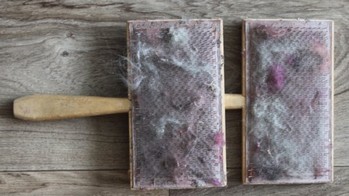
Actually, when the word of Charte is really used in this book, it is written in a proper way, and cannot be read as Chardi.
In searching for a justification, card prohibitions and preachers’ activities come to the mind, but I am not very confident in a similar explanation in this case, and am delaying further reflection on this topic until I find new relevant documents. In any case, other playing sets have been recorded in this book for the whole time interval, more frequently balls of several kinds, but also board games, presumably of the backgammon family.
Card records in the Debitori books
These are two books, in which I was not able to search with the due attention, owing to their many pages (401 and 112 folios, for 3397 and 3398 books respectively) and the lower occurrence of the long lists of goods, in which pinpointing Naibi is easier for me. In particular, I found no useful record in book 3398 and only few of them in book 3397. One should have more patience and time available to perform an exhaustive search here.
In the following Table, all relevant entries found have been summarised.
|
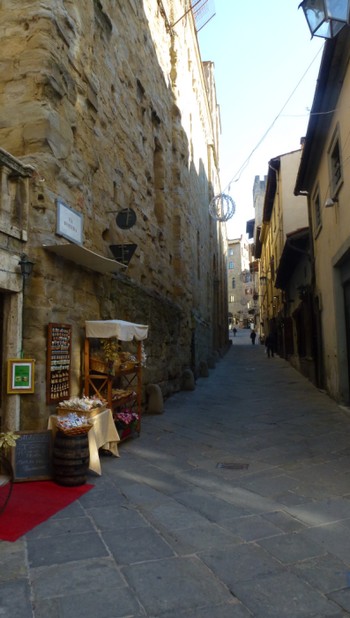
Via di Seteria with shops,
(where Agnolo di Giovanni had his shop)
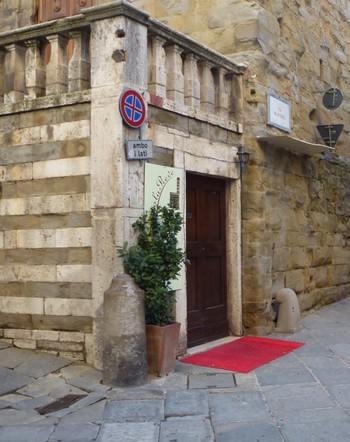
Occasionally the shops are closed
- early in the morning
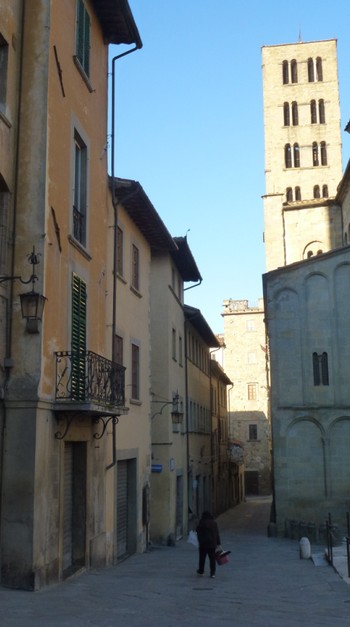
Same street from the other side.
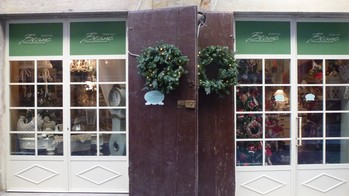
Another shop, open
|
|
|
The information obtained is very limited. About the five kinds of packs indicated, we have no information at all for one of them; two of the four remaining can be situated at the farthest away limits known for card prices - a ratio of 26.4 between the prices of two card packs is really amazing. We are used to consider Fini cards at the top level of the production, but we find them in an intermediate region here, with Vantaggiati clearly at a much higher quality level.
On 15 February 1426 (inserted in a list of trades beginning on 2 August 1425) we find that Mariotto ritagliatore paid L.1 s.2 for “uno paio di Naibi vantaggiati ebe in chasa”. Ritagliatore was one of the professions involved in the production of clothes: he could hardly be considered as a personage used to acquire precious objects.
The sale of Naibi to Bartolomeo speziale seemingly indicates an intermediate trade, in which neither producer nor consumer took part directly.
In these and in other books examined in the ASFdL, I feel that I have left to future researchers further useful information to discover. This has the disadvantage of leaving my work somewhat unfinished, but on the other hand it may provide a beneficial stimulation to anybody who will find suitable conditions for continuing this study.
On my part, I do not exclude to visit again the ASFdL in the next year; however, more than searching further entries in the books examined, I will likely prefer to check further books.
Conclusions
It was expected that this retailer could have recorder more trades of playing cards than his colleagues in Arezzo. Unfortunately, I could only find a few useful records in his account books, as first reported in this note. It may be of interest that these records come from a time that is intermediate between the dates of the other mercers studied earlier on.
The card packs recorded in these trades are few, but may nevertheless provide useful indication on the various qualities offered on sale at the time. As for names of these playing cards, we find both Naibi and Carte used.
Footnotes:
(1) Fraternita dei Laici
(2) Augusto Antoniella, L'archivio della Fraternita dei laici di Arezzo. Vol. II. Milano 1989.
(3) Franco Pratesi 2011/12 - Overview
(4) Franco Pratesi: 1400-1408 – Florence-Arezzo Trade of Naibi, 2012
(5) Franco Pratesi: 1457-71 Cards traded in Arezzo by Stefano Minucci, 2012
(6) ASF, Catasto 273, f. 4v.
(7) ASF, Catasto 329, ff. 143r-151v.
(8) ASFdL 3397, Libro di debitori di bottega (1417-1433).
(9) ASFdL 3398, Libro di debitori di bottega (1433-1449).
(10) ASFdL 3399, Libro dei tintori (1425-1459).
(11) ASFdL 3400, Libro dei creditori (1426-1453).
(12) Franco Pratesi: Cardmakers and Woodblocks on Trial, 2012
(13) Franco Pratesi: Naibi trader at Lapini Store, from 1415 on, 2012
(14) Werner Jacobsen, Die Maler von Florenz zu Beginn der Renaissance. München 2001.
(15) Franco Pratesi: 1429/30 - Naibi traded in Prato by a Notary, 2012
(16) "2 carding shells", picture from commons.wikimedia
|
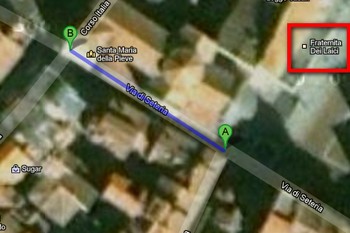
Via di Seteria in Arezzo
|
|






